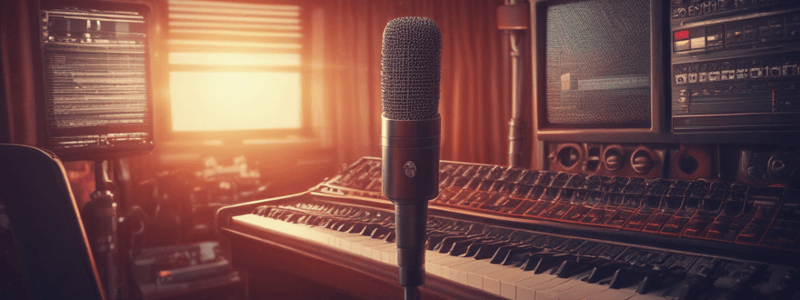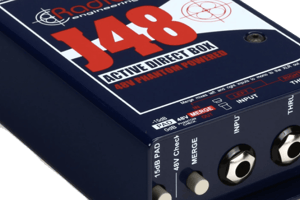Podcast
Questions and Answers
What is the purpose of using a pop filter between the vocalist and the microphone?
What is the purpose of using a pop filter between the vocalist and the microphone?
- To eliminate plosive sounds caused by sudden bursts of air (correct)
- To amplify the vocal sound
- To change the vocal pitch
- To add reverb to the vocal recording
What should you consider when placing a microphone for a soft singer?
What should you consider when placing a microphone for a soft singer?
- Use a dynamic microphone
- Use a condenser microphone
- Move the microphone slightly closer (correct)
- Move the microphone further away
Why is it essential to consider the acoustic environment when placing a microphone?
Why is it essential to consider the acoustic environment when placing a microphone?
- To move the microphone closer to the vocalist
- To add ambiance to the recording
- To reduce unwanted reflections and reverberations (correct)
- To capture more of the vocal sound
What is important to do during a vocal recording session?
What is important to do during a vocal recording session?
Why is experimentation important in microphone placement?
Why is experimentation important in microphone placement?
Where should you position a condenser microphone for acoustic guitar?
Where should you position a condenser microphone for acoustic guitar?
What type of microphone is suitable for capturing the low-frequency response of a bass guitar amplifier?
What type of microphone is suitable for capturing the low-frequency response of a bass guitar amplifier?
Where should you place a dynamic microphone for a kick drum?
Where should you place a dynamic microphone for a kick drum?
What technique can be used to capture the overall drum kit sound?
What technique can be used to capture the overall drum kit sound?
Why is proper microphone placement important for achieving high-quality recordings?
Why is proper microphone placement important for achieving high-quality recordings?
What is essential for achieving clear and professional sound quality in vocal recordings?
What is essential for achieving clear and professional sound quality in vocal recordings?
What type of microphone is more suitable for studio recording?
What type of microphone is more suitable for studio recording?
What is the main purpose of a cardioid polar pattern in microphones?
What is the main purpose of a cardioid polar pattern in microphones?
What is the ideal distance for placing a microphone from the vocalist's mouth?
What is the ideal distance for placing a microphone from the vocalist's mouth?
Why is it recommended to position the microphone at a slightly downward angle?
Why is it recommended to position the microphone at a slightly downward angle?
What is the primary advantage of using dynamic microphones?
What is the primary advantage of using dynamic microphones?
What is the main difference between dynamic and condenser microphones?
What is the main difference between dynamic and condenser microphones?
What is the primary purpose of using microphones with different polar patterns?
What is the primary purpose of using microphones with different polar patterns?
What is a common cause of feedback issues?
What is a common cause of feedback issues?
What can help minimize external noise and sound leakage?
What can help minimize external noise and sound leakage?
What can reduce the chances of resonant frequencies and prevent feedback?
What can reduce the chances of resonant frequencies and prevent feedback?
What can be used to automatically detect and eliminate feedback frequencies in real-time?
What can be used to automatically detect and eliminate feedback frequencies in real-time?
What is a recommended step when experiencing feedback issues?
What is a recommended step when experiencing feedback issues?
What can be affected by adjusting EQ settings?
What can be affected by adjusting EQ settings?
What may be beneficial when experiencing persistent feedback issues?
What may be beneficial when experiencing persistent feedback issues?
What is required to achieve optimal results in addressing feedback issues?
What is required to achieve optimal results in addressing feedback issues?
What is the recommended microphone placement for a piano?
What is the recommended microphone placement for a piano?
What type of microphone is suitable for a trumpet?
What type of microphone is suitable for a trumpet?
What is the purpose of using directional microphones?
What is the purpose of using directional microphones?
What is the cause of feedback in a microphone system?
What is the cause of feedback in a microphone system?
What is the purpose of using a notch filter?
What is the purpose of using a notch filter?
What is the recommended way to angle the speakers in relation to the microphone?
What is the recommended way to angle the speakers in relation to the microphone?
What is the benefit of using in-ear monitors?
What is the benefit of using in-ear monitors?
Why is it important to experiment with different microphone placements and angles?
Why is it important to experiment with different microphone placements and angles?
What is the purpose of using a high-pass filter?
What is the purpose of using a high-pass filter?
What is the recommended way to adjust the monitor mix on stage?
What is the recommended way to adjust the monitor mix on stage?
Flashcards are hidden until you start studying
Study Notes
Microphone Placement for Vocals
- Understanding proper microphone placement is essential for achieving clear and professional sound quality in vocal recordings.
- There are two main types of microphones: dynamic microphones, which are more rugged and versatile, and condenser microphones, which offer unparalleled sensitivity and detail.
- Microphones have different polar patterns, including cardioid, omnidirectional, and bi-directional, with cardioid pattern microphones being commonly used for vocal recording due to their ability to reject unwanted background noise.
Ideal Microphone Placement
- Place the microphone approximately 6-12 inches from the vocalist's mouth to capture the vocals clearly while minimizing the chances of plosive sounds or excessive sibilance distorting the recording.
- Position the microphone at a slightly downward angle, pointing towards the vocalist's mouth, to reduce the chances of capturing excessive breath sounds, lip smacking, or the singer's nose.
- Using a pop filter between the vocalist and the microphone can help eliminate plosive sounds caused by sudden bursts of air hitting the microphone diaphragm.
Adjusting for Different Vocal Styles
- For softer vocals, move the microphone slightly closer to capture the nuances and details of the performance.
- For powerful vocals, move the microphone slightly farther away to prevent distortion or clipping due to high sound pressure levels.
Acoustic Treatment
- Consider the acoustic environment when placing the microphone, as reflections and reverberations can negatively impact the recording.
- Place the vocalist in a well-treated acoustic space or use acoustic panels and diffusers to minimize unwanted reflections.
Experimentation
- Remember that these guidelines should be used as a starting point, and every vocalist and song may require different adjustments to achieve the desired sound.
- Experiment with microphone placement, angles, and distances to find the setup that best suits the vocalist's voice and performance style.
Microphone Techniques for Instruments
Acoustic Guitar
- Position a condenser microphone about 6-12 inches away from the 12th fret of the guitar.
- Experiment with pointing the microphone towards the soundhole or the neck of the guitar to find the desired tone.
- Consider using a small diaphragm condenser microphone for a more transparent sound.
Electric Guitar Amplifier
- Place a dynamic microphone close to the center of the speaker cone to capture the most focused and balanced sound.
- Experiment with different distances and angles to find the desired tonal characteristics.
- Use a dynamic microphone with a high SPL (Sound Pressure Level) handling capability to avoid distortion.
Bass Guitar Amplifier
- Position a dynamic microphone near the speaker cone to capture the low-frequency response accurately.
- Use a microphone with a larger diaphragm or a dedicated bass microphone to capture the extended low-end of the instrument.
Drums
- Kick Drum: Place a dynamic microphone just inside the drum's hole or use a dedicated kick drum microphone for better low-frequency response.
- Snare Drum: Position a dynamic microphone above the drum, near the rim, or use a clip-on dynamic microphone for the top head.
- Tom Drums: Place dynamic microphones close to the drumhead for a focused sound, experiment with different angles for desired attack and resonance.
- Overhead: Use condenser microphones or stereo microphone techniques like XY or ORTF to capture the overall drum kit sound.
Piano
- Position a pair of condenser microphones in an XY or spaced pair configuration, slightly above the opened lid.
- Experiment with different distances and angles to capture the desired balance between the strings and resonance of the piano.
Brass Instruments
- Trumpet, Trombone, Saxophone: Use dynamic or condenser microphones with a small diaphragm, positioned a few inches away from the bell.
- Experiment with different angles and distances to capture the desired tonal characteristics and balance.
Strings
- Violin, Viola, Cello: Use a small diaphragm condenser microphone positioned near the instrument's bridge or fingerboard.
- Experiment with different distances to capture the desired balance between the instrument's tone and room ambience.
Addressing Feedback Issues
Understanding Feedback Issues
- Feedback occurs when the sound picked up by the microphone is amplified and re-fed into the system, causing a high-pitched squealing or screeching sound.
Microphone and Speaker Placement
- Keep the microphone away from the speakers to reduce the chances of feedback.
- Use directional microphones, such as cardioid or supercardioid, which are more resistant to feedback compared to omnidirectional microphones.
- Position speakers properly, angling them away from the microphone and towards the audience.
Equalization and Filtering
- Cut problematic frequencies using a parametric or graphic equalizer to address feedback issues.
- Use notch filters to eliminate a narrow range of frequencies causing feedback.
- Use high-pass filters to remove low-frequency rumble and reduce the chances of feedback from stage vibrations or other low-frequency sources.
Monitor Mix and Stage Volume
- Ensure proper gain staging to avoid excessive gain, which can lead to feedback issues.
- Adjust monitor mix carefully to avoid excessive stage monitor volume, which can cause feedback.
- Use in-ear monitors to provide a personalized monitor mix directly to the performer's ears, eliminating the need for stage monitor speakers and reducing the chances of feedback.
Soundproofing and Acoustic Treatment
- Soundproof the venue to minimize external noise and sound leakage, which can contribute to feedback issues.
- Use acoustic panels and diffusers to enhance the room's acoustics and reduce the chances of resonant frequencies and feedback.
Troubleshooting Techniques
- Move the microphone away from the source of the feedback to solve the problem.
- Adjust EQ settings to cut problematic frequencies or boost desired ones.
- Use feedback suppression equipment to automatically detect and eliminate feedback frequencies in real-time.
- Consult an audio professional for further guidance and assistance if feedback issues persist.
Studying That Suits You
Use AI to generate personalized quizzes and flashcards to suit your learning preferences.





